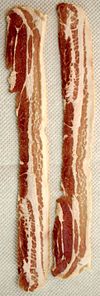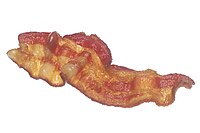Bacon

Bacon is defined as any of certain cuts of meat taken from the sides, belly or back of a pig that may be cured and/or smoked. Meat from other animals may also be cured or otherwise prepared to resemble bacon, such as chicken or turkey bacon. In continental Europe, it is used primarily in cubes (lardons) as a cooking ingredient valued both as a source of fat and for its flavour. In Italy, besides being used in cooking, bacon (pancetta) is also served uncooked and thinly sliced as part of an antipasto. Bacon is also used for barding and larding roasts, especially game birds. Many people prefer to have their bacon smoked by using various types of woods. This process can take up to ten hours depending on the intensity of the flavour desired. Bacon may be eaten fried, baked, or grilled. It is commonly used in sandwiches.
A side of unsliced bacon is a flitch or slab bacon, while an individual slice of bacon is a rasher (United Kingdom, Republic of Ireland, Australia and New Zealand) or simply a slice or strip (North America). Slices of bacon are also known as collops. Traditionally, the skin is left on the cut and is known as bacon rind. Rindless bacon, however, is quite common. In the United Kingdom and Republic of Ireland, bacon comes in a wide variety of cuts and flavours whereas bacon in the United States is predominantly what is known as "streaky bacon", or "streaky rashers" in the United Kingdom and Republic of Ireland. Bacon made from the meat on the back of the pig is referred to as back bacon and is part of traditional British and Irish breakfasts. In North America, back bacon may also be referred to as Canadian-style Bacon or Canadian Bacon.[1]
The USDA defines bacon as "the cured belly of a swine carcass," while other cuts and characteristics must be separately qualified (e.g. "smoked pork loin bacon").[2] "USDA Certified" bacon means that it has been treated for trichinella.
Cuts of bacon


Rashers or slices differ depending where they are cut from:
- Streaky bacon comes from the belly of a pig. It is very fatty with long veins of fat running parallel to the rind. This is the most common form of bacon in the United States. Pancetta is Italian streaky bacon, smoked or green (unsmoked), with a strong flavour. It is generally rolled up into cylinders after curing.
- Back bacon comes from the loin in the middle of the back of the pig. It is a lean meaty cut of bacon, with relatively less fat compared to other cuts and has a ham-like texture and flavour. Most bacon consumed in the United Kingdom is back bacon. [3]
- Middle bacon is much like back bacon but is cheaper and somewhat fattier, with a richer flavour.
- Cottage bacon, thinly sliced lean pork meat from a shoulder cut that is typically oval shaped and meaty. It is cured and then sliced into round pieces for baking or frying.
- Jowl bacon, is cured and smoked cheeks of pork
Bacon joints include the following:
- Collar bacon is taken from the back of a pig near the head.
- Hock, from the hog ankle joint between the ham and the foot.
- Gammon, from the hind leg, traditionally "Wiltshire cured".
- Picnic bacon is from the picnic cut, which includes the shoulder beneath the blade.[1] It is fairly lean, but tougher than most pork cuts.
Back bacon or Canadian bacon

Back bacon is a lean meaty cut of bacon.
Canadian bacon is a term used in the United States but elsewhere it is simply back bacon. It refers to any lean meaty cut of bacon. In Canada back bacon is sometimes known as peameal bacon, which refers to a specific variety of unsmoked lean bacon that has been sweet pickle-cured and coated in yellow cornmeal (originally, as the name suggests, peameal was used). Other proteins, such as turkey and beef, can be made in the style of peameal bacon by employing this same sweet pickle and cornmeal process.
Often times in the US, products sold as "canadian bacon" are actually nothing more than pieces ham cut into circles and is not the true peameal bacon popular in Canada. Such "canadian bacon" is a popular ingredient in fast-food breakfast sandwiches, including the Egg McMuffin.
Precooked bacon
In recent years in North America, pre-cooked bacon, which can be eaten out of the package or quickly reheated, has become a popular alternative to traditional bacon. Pre-cooked bacon, by USDA definition, is bacon which has been cooked to a finished yield of 40% or less. In other words, if 1 pound of raw bacon is cooked to 0.4 pounds or less, then it may be labeled as fully cooked bacon. Most pre-cooked bacon is considered shelf stable (may be stored safely at room temperature) because it is vacuum-sealed, has a high brine concentration, and the water activity is low enough to prevent the outgrowth of pathogenic organisms.[4]
Bacon used as a topping

In the US and Europe, bacon is often used as a condiment or topping on other foods. Streaky bacon is more commonly used as a topping in the US, on items such as pizza, salads, sandwiches, baked potatoes, hot dogs and soups. Back bacon is used less frequently in the United States, but can sometimes be found on pizza, salads and omelets.
In Eastern Europe
It is a custom in areas of Eastern Europe such as Hungary and Slovakia to roast bacon over a rotisserie grill, the dripping fat being put onto a slice of ham with radish, green pepper, and Paprika. Other ingredients may also be used. Later innovations include the use of a bread toasting pan used in camping to catch the drippings. At campfires, Hungarians typically roast bacon on a stick, catching the drippings on a slice of bread, and wash it down with a drink of Palinka, the local brandy. In Hungary, bacon is also traditionally consumed as part of a cold meal, such as breakfast or supper, cut into small, bite-size slices, and eaten with white bread, yellow wax-peppers, and tomatoes.
Nutrients
Select nutritional data from types of bacon in the USDA National Nutrient Database:[5]
| Streaky bacon, raw |
Streaky bacon, cooked |
Canadian style bacon, cooked |
Hormel Canadian Style Bacon | |
|---|---|---|---|---|
| Amount | 1 slice | 1 slice | 2 slices | 1 serving |
| Total Weight (g) | 29 | 8 | 47 | 56 |
| Water (g) | 3.57 (12%) | 0.99 (12%) | 29 (62%) | 40.85 (73%) |
| Calories | 157 | 43 | 87 | 68 |
| Total Fat (g) | 12.12 | 3.34 | 3.97 | 9.45 |
| Saturated Fat (g) | 3.984 | 1.099 | 1.335 | 1.025 |
| Cholesterol (mg) | 32 | 9 | 27 | 27 |
| Sodium (mg) | 670 | 185 | 727 | 569 |
| Protein (g) | 10.74 | 2.96 | 11.39 | 9.45 |
See also
References
- ^ a b Cattleman's Beef Board & National Cattlemen's Beef Association. Uniform Retail Meat Identity Standards. Retrieved 2007-07-09.
- ^ United States Department of Agriculture, Food Safety and Inspection Service. USDA Food Safety and Inspection Service: Glossery B. Retrieved 2007-07-09.
- ^ Danish Bacon Company. Information and Statistics 2005. Retrieved 2007-07-20.
- ^ USDA, Food Safety and Inspection Service. Food Safety Regulatory Essentials: HACCP for Shelf Stable Products, Introduction. Retrieved 2007-07-09.
- ^ USDA, Agricultural Research Service, Nutrient Data Laboratory. USDA National Nutrient Database for Standard Reference. Retrieved 2007-07-12.
External links
- Cooking For Engineers - Cooking Tests: Bacon (Part I) | (Part II)
- About.com- History of Bacon Part III
